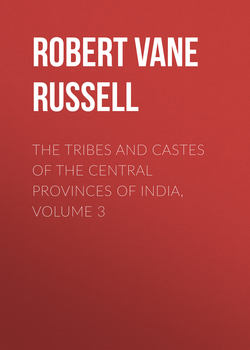Читать книгу The Tribes and Castes of the Central Provinces of India, Volume 3 - Robert Vane Russell - Страница 14
Gauria
ОглавлениеGauria.21—A small caste of snake-charmers and jugglers who are an offshoot of the Gond tribe. They number about 500 persons and are found only in Chhattīsgarh. They have the same exogamous septs as the Gonds, as Markām, Marai, Netām, Chhedaiha, Jagat, Purteti, Chichura and others. But they are no doubt of very mixed origin, as is shown by the fact that they do not eat together at their feasts, but the guests all cook their own food and eat it separately. And after a daughter has been married her own family even will not take food from her hand because they are doubtful of her husband’s status. It is said that the Gaurias were accustomed formerly to beg only from the Kewat caste, though this restriction is no longer maintained. The fact may indicate that they are partly descended from the unions of Kewats with Gond women.
Adult marriage is the general rule of the caste and a fixed bride-price of sixteen rupees is paid. The couple go away together at once and six months afterwards return to visit the bride’s parents, when they are treated as outsiders and not allowed to touch the food cooked for the family, while they reciprocally insist on preparing their own. Male Gaurias will take food from any of the higher castes, but the women will eat only from Gaurias. They will admit outsiders belonging to any caste from whom they can take food into the community. And if a Gauria woman goes wrong with a member of any of these castes they overlook the matter and inflict only a feast as a penalty.
Their marriage ceremony consists merely in the placing of bangles on the woman’s wrists, which is the form by which a widow is married among other castes. If a widow marries a man other than her husband’s younger brother, the new husband must pay twelve rupees to her first husband’s family, or to her parents if she has returned to them. If she takes with her a child born of her first husband with permission to keep it, the second husband must pay eight rupees to the first husband’s family as the price of the child. But if the child is to be returned as soon as it is able to shift for itself the second husband receives eight rupees instead of paying it, as remuneration for his trouble in rearing the baby. The caste bury their dead with the feet to the south, like the Hindus. The principal business of the Gaurias is to catch and exhibit snakes, and they carry a damru or rattle in the shape of an hour-glass, which is considered to be a distinctive badge of the caste. If a Gauria saw an Ojha snake-charmer carrying a damru he would consider himself entitled to take it from the Ojha forcibly if he could. A Gauria is forbidden to exhibit monkeys under penalty of being put out of caste. Their principal festival is the Nāg-Panchmi, when the cobra is worshipped. They also profess to know charms for curing persons bitten by snakes. The following incantation is cried by a Gauria snake-doctor three times into the ears of his patient in a loud voice:
“The bel tree and the bel leaves are on the other side of the river. All the Gaurias are drowned in it. The breast of the koil; over it is a net. Eight snakes went to the forest. They tamed rats on the green tree. The snakes are flying, causing the parrots to fly. They want to play, but who can make them play? After finishing their play they stood up; arise thou also, thou sword. I am waking you (the patient) up by crying in your ear, I conjure you by the name of Dhanvantari22 to rise carefully.”
Similar meaningless charms are employed for curing the bites of scorpions and for exorcising bad spirits and the influence of the evil eye.
The Gaurias will eat almost all kinds of flesh, including pigs, rats, fowls and jackals, but they abstain from beef. Their social status is so low that practically no caste will take food or water from them, but they are not considered as impure. They are great drunkards, and are easily known by their damrus or rattles and the baskets in which they carry their snakes.
21
This article is based on papers by Mr. Jeorākhān Lāl, Deputy Inspector of Schools, Bilāspur, and Bhagwān Singh, Court of Wards Clerk, Bilāspur.
22
The Celestial Physician.
